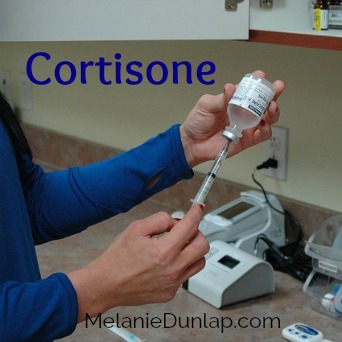Cortisone shot. Just hearing the words can cause a visceral reaction in the body. If you’ve ever had one it hurt, if you watched someone get one it looked like it hurt. If you tell someone about getting a cortisone shot, they will eagerly share the painful details of their own experience.
I watched my husband get cortisone shots in his thumb after an injury and he reported it hurt like hell. It was painful to watch because the doctor had to poke around to get the needle in the right spot. I got one in my shoulder, it hurt but not as bad as what he experienced.
What is cortisone?
Cortisone is a type of medication called a corticosteroid. Also known as a steroid, it is a synthetic drug similar to cortisol. Your adrenal glands naturally produce cortisol and release it into the bloodstream when the body is under stress. Natural cortisol is a steroid hormone that regulates carbohydrate metabolism and has an anti-inflammatory effect on the body.
Naturally produced cortisol is relatively short-acting but injectable cortisone is synthetically produced and designed to be more potent and act for a longer period of time. Synthetic cortisone is not injected into the bloodstream, but into a particular area of concern, such as a painful joint.
Cortisone is not the same type of steroid taken by people that want to grow big muscles. There are different types of steroids for different uses.
How does it work?
Corticosteroids work by decreasing inflammation and reducing the activity of the immune system. Although the cortisone injection is not a true pain-killer, it works by reducing inflammation. When the inflammation is reduced the pain is also reduced.
The cortisone is injected directly into the area of inflammation, most often joints like the ankle, elbow, knee, shoulder, hip, spine and wrist. Conditions such as bursitis, arthritis, trigger finger and carpal tunnel syndrome are often treated with cortisone injections. Another common use is to treat shoulder pain caused by either rotator cuff damage or a frozen shoulder.
Is it enough?
Getting a cortisone injection often feels like a magic bullet. Within a few days the pain is usually subsided, and the effects can last up to several weeks. Don’t mistake lack of pain as lack of injury. Pain is the body’s warning system. Cortisone temporarily turns off the warning system in that area. There may be a reduction in the pain and inflammation, but just getting an injection is not enough.
Cortisone injections don’t cure a condition, but they can provide relief from symptoms. During this symptom free time is when manual therapy and exercise are crucial. Doing the right exercises can improve joint motion and muscle strength which can decrease the chance of a recurrence.
If your healthcare provider suggests a cortisone shot be sure to make an informed decision. Diabetics may experience an increase in blood sugar and 2% of people experience temporary increased pain from a reaction called cortisone flare. A flare is short-lived and can be treated with ice. Most side effects are minimal unless the injection is overused or used incorrectly.
Treating the root cause of pain and inflammation is the only way to achieve lasting healing. Remember that cortisone should be just one part in your holistic treatment plan.
.
Have you ever had a cortisone injection? Tell us about your experience in the comments below!
